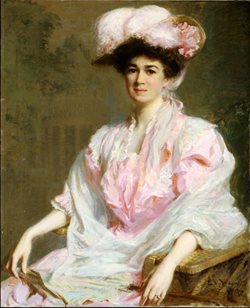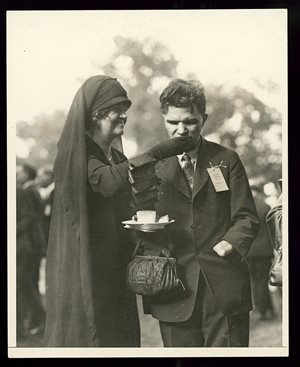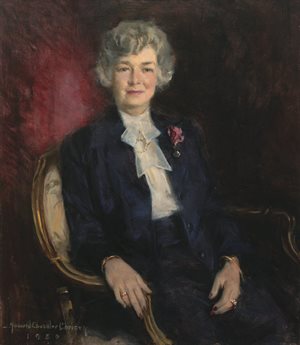By Cathi Taylor, ALA National Headquarters Archivist
 March has arrived — a month where we celebrate the contributions and impact women have made to history, culture, and society. It is an opportunity to pay tribute to all women and their achievements.
March has arrived — a month where we celebrate the contributions and impact women have made to history, culture, and society. It is an opportunity to pay tribute to all women and their achievements.
The American Legion Auxiliary has been home to some of these movers and shakers. Today, we will look at a New England member who called Lowell, Mass., home. By coupling a personal tragedy with her own experiences, this woman launched a career that prompted improvements in the lives of veterans and their families, and cleared a path for women in the military. Her name was Edith Frances Nourse Rogers.
Born on Oct. 19, 1881, she had all the advantages of an established New England family. The family moved to Lowell when Rogers was a young girl, and it was in Lowell where she married John Jacob Rogers in 1907. She would later become the first woman to be sent to Congress from New England (1925) to fill the vacancy caused by the unexpected death of her husband. However, she did not come to the nation’s capital unprepared.
During the Great War, as a member of the House Foreign Affairs Committee, Rogers’ husband was sent to France in 1917 and she went as well. It was there that she volunteered with the American Red Cross and also provided information to U.S. President Woodrow Wilson on the medical care given to the wounded American soldiers by England and France.
When Rogers returned with her husband in 1918, she continued her Red Cross work and became the first member of the “Gray Ladies of Walter Reed Hospital.” Not only did she tend to the physical needs of the wounded soldiers, she sought to help them with other matters. Rogers helped get their compensation claims started, their Liberty Bond payments adjusted, collect their Army pay, and much more. She became known to the Doughboys as the “Angel of Walter Reed Hospital.”
In 1922, President Warren G. Harding appointed Rogers to visit the hospitals and report on the care of the disabled veterans, report all discrepancies in veterans’ work, and recommend remedial action. She was reappointed in 1923 by President Calvin Coolidge and again by President Herbert Hoover. Rogers often traveled by airplane, a mode of transportation not normally used by women.
 And then, unexpectedly, her husband died in March 1925. Encouraged by many, she ran for his seat and won in a landslide. She became the sixth woman in Congress and served for 35 years — until her death in 1960.
And then, unexpectedly, her husband died in March 1925. Encouraged by many, she ran for his seat and won in a landslide. She became the sixth woman in Congress and served for 35 years — until her death in 1960.
I don’t know if one could put together a more enviable political record. She worked tirelessly, sponsoring more than 1,200 bills with more than half of those on military and veteran issues. She opposed child labor, a 48-hour work week for women, and equal pay for equal work. Rogers was one of the first members of Congress to speak against Adolf Hitler in the years preceding World War II.
I attempted to locate a list of bills Rogers had a hand in creating but was unable to find one. Perhaps that would require a trip to Washington, D.C.; however, I am able to talk about two of the more powerful laws that passed.
In early 1941, Rogers drafted and sponsored the bill creating the Women’s Army Auxiliary Corps. The bill floundered until Pearl Harbor. It was signed into law on May 14, 1942. But it wasn’t enough because women still didn’t have full military rights. She returned to the drawing board, and on July 1, 1943, President Franklin D. Roosevelt signed the bill authorizing the Women’s Army Corps.
American Legion Past National Commander Harry Colmery is credited with writing the first draft of this next bill, but Rogers had her hand in it as well. Not only did she co-sponsor the bill, but she helped write the Servicemen’s Readjustment Act of 1944, aka the GI Bill of Rights. Because of her effort on the bill, President Roosevelt handed Rogers the first pen.
 In 1950, she was honored by the Department of Massachusetts Legion Family for her efforts on behalf of veterans with a portrait of her, which was unveiled in Washington, D.C. Painted by artist Howard Chandler Christy, the portrait is now part of the House of Representatives collection. The American Legion awarded Rogers the Distinguished Service Medal, and the Auxiliary honored her as well. The E.N. Rogers Middle School in Lowell was named for her, and President Jimmy Carter renamed the Bedford Veterans Affairs Medical Center in her honor — the Edith Nourse Rogers Memorial Veterans Hospital. More recently, the Harry W. Colmery Veterans Educational Assistance Act of 2017 (aka the Forever GI Bill) was signed into law and contains a new Edith Nourse Rogers Science, Technology, Engineering, and Mathematics (STEM) Scholarship in her honor.
In 1950, she was honored by the Department of Massachusetts Legion Family for her efforts on behalf of veterans with a portrait of her, which was unveiled in Washington, D.C. Painted by artist Howard Chandler Christy, the portrait is now part of the House of Representatives collection. The American Legion awarded Rogers the Distinguished Service Medal, and the Auxiliary honored her as well. The E.N. Rogers Middle School in Lowell was named for her, and President Jimmy Carter renamed the Bedford Veterans Affairs Medical Center in her honor — the Edith Nourse Rogers Memorial Veterans Hospital. More recently, the Harry W. Colmery Veterans Educational Assistance Act of 2017 (aka the Forever GI Bill) was signed into law and contains a new Edith Nourse Rogers Science, Technology, Engineering, and Mathematics (STEM) Scholarship in her honor.
Edith Rogers died Sept. 10, 1960, during her 19th congressional campaign. Approximately 40,000 people paid a final tribute to her. At the cemetery, 300 soldiers from the 2nd Infantry Brigade, Fort Devens, lined both sides of the road leading to a vault in the family lot. An honor guard that represented the four military branches walked on each side of her casket. Firing the salute was the Edith Nourse Rogers Chapter of the Disabled Army Veterans and a W.A.C. detachment of 20 women played Taps.
At the 1960 American Legion Auxiliary National Convention, Resolutions Chairman Helen Gilbert presented a resolution to the convention delegates stating, “Resolved, That the American Legion Auxiliary, assembled at Miami Beach, Florida, for its Fortieth Annual Convention, rise in a moment of solemn tribute and gratitude to a most distinguished citizen, legislator, and friend, a dedicated member of Lowell Unit No. 87, Department of Massachusetts, American Legion Auxiliary: The Honorable Edith Nourse Rogers.”
Well done, good and faithful servant.
ALA Digital Archive Collection
To learn more about the history of the American Legion Auxiliary, please visit our digital archive collection at https://alaforveterans.pastperfectonline.com.